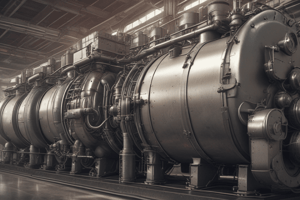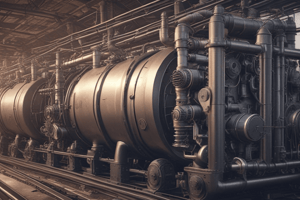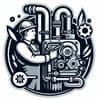Podcast
Questions and Answers
What is the main purpose of a steam condenser?
What is the main purpose of a steam condenser?
- To increase back pressure on the exhaust side of the piston
- To condense steam and absorb heat released by it (correct)
- To decrease thermal efficiency of the engine
- To reduce the available heat energy for converting into mechanical work
Why does a condensing unit have higher thermal efficiency compared to a non-condensing unit?
Why does a condensing unit have higher thermal efficiency compared to a non-condensing unit?
- Because it allows the steam to expand to a greater extent (correct)
- Because it can only be used with high-pressure steam engines
- Because it uses more water for cooling purposes
- Because it has a higher back pressure
Which organ of a Steam Condensing Plant is responsible for removing the condensed steam, air, and uncondensed water vapour and gases from the condenser?
Which organ of a Steam Condensing Plant is responsible for removing the condensed steam, air, and uncondensed water vapour and gases from the condenser?
- Hot well
- Wet air pump (correct)
- Condenser
- Supply of cooling water
What is the function of the hot well in a Steam Condensing Plant?
What is the function of the hot well in a Steam Condensing Plant?
Which component of a Steam Condensing Plant is responsible for removing heat released by steam?
Which component of a Steam Condensing Plant is responsible for removing heat released by steam?
How does a condensing unit benefit the available heat energy for converting into mechanical work?
How does a condensing unit benefit the available heat energy for converting into mechanical work?
What is the function of a turbine nozzle in an impulse turbine?
What is the function of a turbine nozzle in an impulse turbine?
What is the purpose of the throat in a convergent-divergent nozzle?
What is the purpose of the throat in a convergent-divergent nozzle?
Why does a convergent-divergent nozzle produce steam at higher velocities than a convergent nozzle?
Why does a convergent-divergent nozzle produce steam at higher velocities than a convergent nozzle?
What effect does internal friction of steam have on nozzle efficiency?
What effect does internal friction of steam have on nozzle efficiency?
Which factor contributes to frictional losses in a convergent-divergent nozzle?
Which factor contributes to frictional losses in a convergent-divergent nozzle?
What is the adiabatic assumption about the flow of steam through a nozzle?
What is the adiabatic assumption about the flow of steam through a nozzle?
What type of surface condenser has the air suction at the top and the steam enters at the bottom?
What type of surface condenser has the air suction at the top and the steam enters at the bottom?
Which type of surface condenser allows the exhaust steam to flow in a direction right angle to the direction of flow of water?
Which type of surface condenser allows the exhaust steam to flow in a direction right angle to the direction of flow of water?
What is the underlying principle of an evaporative condenser?
What is the underlying principle of an evaporative condenser?
What is a key advantage of using a surface condenser?
What is a key advantage of using a surface condenser?
Which factor contributes to reducing the pressure drop of steam in a central flow type condenser?
Which factor contributes to reducing the pressure drop of steam in a central flow type condenser?
What distinguishes a regenerative type condenser from other types?
What distinguishes a regenerative type condenser from other types?
Why is it important to clean the cooling water used in surface condensers?
Why is it important to clean the cooling water used in surface condensers?
What is the purpose of a non-return valve provided at the exhaust steam inlet?
What is the purpose of a non-return valve provided at the exhaust steam inlet?
What is the formula to calculate the corrected vacuum in mm of Hg?
What is the formula to calculate the corrected vacuum in mm of Hg?
What is the formula for vacuum efficiency?
What is the formula for vacuum efficiency?
What does condenser efficiency measure?
What does condenser efficiency measure?
What is the purpose of a cooling tower in power plants?
What is the purpose of a cooling tower in power plants?
Which factor does NOT affect the cooling of water in a cooling tower?
Which factor does NOT affect the cooling of water in a cooling tower?
What distinguishes natural draught cooling towers from mechanical draught cooling towers?
What distinguishes natural draught cooling towers from mechanical draught cooling towers?
What are some advantages of concrete hyperbolic cooling towers over mechanical towers?
What are some advantages of concrete hyperbolic cooling towers over mechanical towers?
What is the main function of a steam nozzle?
What is the main function of a steam nozzle?
Which classification is NOT used for cooling towers based on material composition?
Which classification is NOT used for cooling towers based on material composition?
In a natural draught cooling tower, how is heat removed from falling water?
In a natural draught cooling tower, how is heat removed from falling water?
What is the difference between a jet condenser and a surface condenser?
What is the difference between a jet condenser and a surface condenser?
What is the purpose of a baffle plate in a low level jet condenser?
What is the purpose of a baffle plate in a low level jet condenser?
Which type of jet condenser does not require an extraction pump?
Which type of jet condenser does not require an extraction pump?
What is the purpose of the perforated trays in a low-level counter-flow jet condenser?
What is the purpose of the perforated trays in a low-level counter-flow jet condenser?
What is another name for a high-level counter-flow jet condenser?
What is another name for a high-level counter-flow jet condenser?
What is the function of an air suction pump in a low level jet condenser?
What is the function of an air suction pump in a low level jet condenser?
Where does the cold water flow in an ejector condenser?
Where does the cold water flow in an ejector condenser?
What happens to the pressure energy of condensed steam, cooling water, and air in an ejector condenser?
What happens to the pressure energy of condensed steam, cooling water, and air in an ejector condenser?
Flashcards are hidden until you start studying
Study Notes
Vacuum Measurement and Correction
- Vacuum is measured in mm of Hg using a vacuum gauge
- Corrected vacuum in mm of Hg = (760 - Absolute pressure in mm of Hg) = 760 - (Actual barometric height - Actual vacuum)
Vacuum Efficiency
- Defined as the ratio of actual vacuum to maximum obtainable vacuum
- Maximum obtainable vacuum is when only steam is present in the condenser, with no air
- Vacuum efficiency = Actual vacuum / Maximum obtainable vacuum = Actual vacuum / (Barometer pressure - Absolute pressure of steam)
Condenser Efficiency
- Defined as the ratio of the difference between outlet and inlet temperatures of cooling water to the difference between the temperature corresponding to the vacuum in the condenser and inlet temperature of cooling water
- Condenser efficiency = Rise in temperature of cooling water / (Temp. corresponding to vacuum in the condenser - Inlet temp. of cooling water)
Cooling Towers
- Used to cool hot water from the condenser so it can be reused
- Water is made to trickle down in contact with air, causing some water to evaporate and cool the remaining water
- Factors affecting cooling of water in a cooling tower:
- Temperature of air
- Humidity of air
- Temperature of hot water
- Size and height of tower
- Velocity of air entering tower
- Accessibility of air to all parts of tower
- Degree of uniformity in descending water
- Arrangement of plates in tower
Classification of Cooling Towers
- Natural draught cooling towers
- Mechanical draught cooling towers
- Forced draught cooling towers
- Induced draught cooling towers
Natural Draught Cooling Tower
- Hot water is pumped to troughs and nozzles, then sprayed into a pond, where air enters and takes up heat
- Advantages:
- Low operating and maintenance cost
- Trouble-free operation
- Less ground area required
- Can be built to withstand high winds
- Disadvantages:
- High initial cost
- Performance varies with seasonal changes in air temperature and humidity
Steam Condenser
- A device that condenses steam and absorbs heat released by steam
- Serves two purposes:
- Maintains a very low back pressure on the exhaust side of the piston or turbine
- Supplies pure and hot feed water to the boiler
Organs of a Steam Condensing Plant
- Condenser
- Supply of cooling water
- Wet air pump (to remove condensed steam, air, and uncondensed water vapor and gases)
- Hot well (where condensate is collected and used as feed water for the boiler)
Steam Nozzle
- A passage of varying cross-section that converts heat energy of steam into kinetic energy
- Major function: to produce a steam jet with high velocity to drive steam turbines
- Two types:
- Convergent nozzle
- Convergent-divergent nozzle
Steam Flow through Nozzles
- Assumed to be adiabatic flow since no heat is added or rejected during expansion
- Work done is equal to adiabatic heat drop, which is equal to Rankine area
Nozzle Efficiency
- Defined as the ratio of actual velocity of steam to ideal velocity
- Reduced due to frictional losses between the nozzle surface and steam, and internal friction of steam itself
- Derivation of nozzle efficiency is shown in diagrams
Surface Condensers
- Classified into:
- Down flow type
- Central flow type
- Inverted flow type
- Regenerative type
- Evaporative type
- Advantages:
- Slightly better vacuum can be obtained
- No need to treat the condensate chemically
- High vacuum (about 73.5 cm Hg) can be obtained
- Condensate can be reused as boiler feed water
- Low pumping power required
- Less chance of losing vacuum
- Disadvantages:
- High initial cost
- Requires large floor area
- High maintenance cost
- More head is necessary to obtain sufficient head on hot well pump
- Proper cleaning of cooling water is necessary
Classification of Condensers
- Jet Condenser
- Parallel-flow type
- Counter-flow type
- Ejector type
- Surface Condenser
- Single-pass type
- Double-pass type
Studying That Suits You
Use AI to generate personalized quizzes and flashcards to suit your learning preferences.






